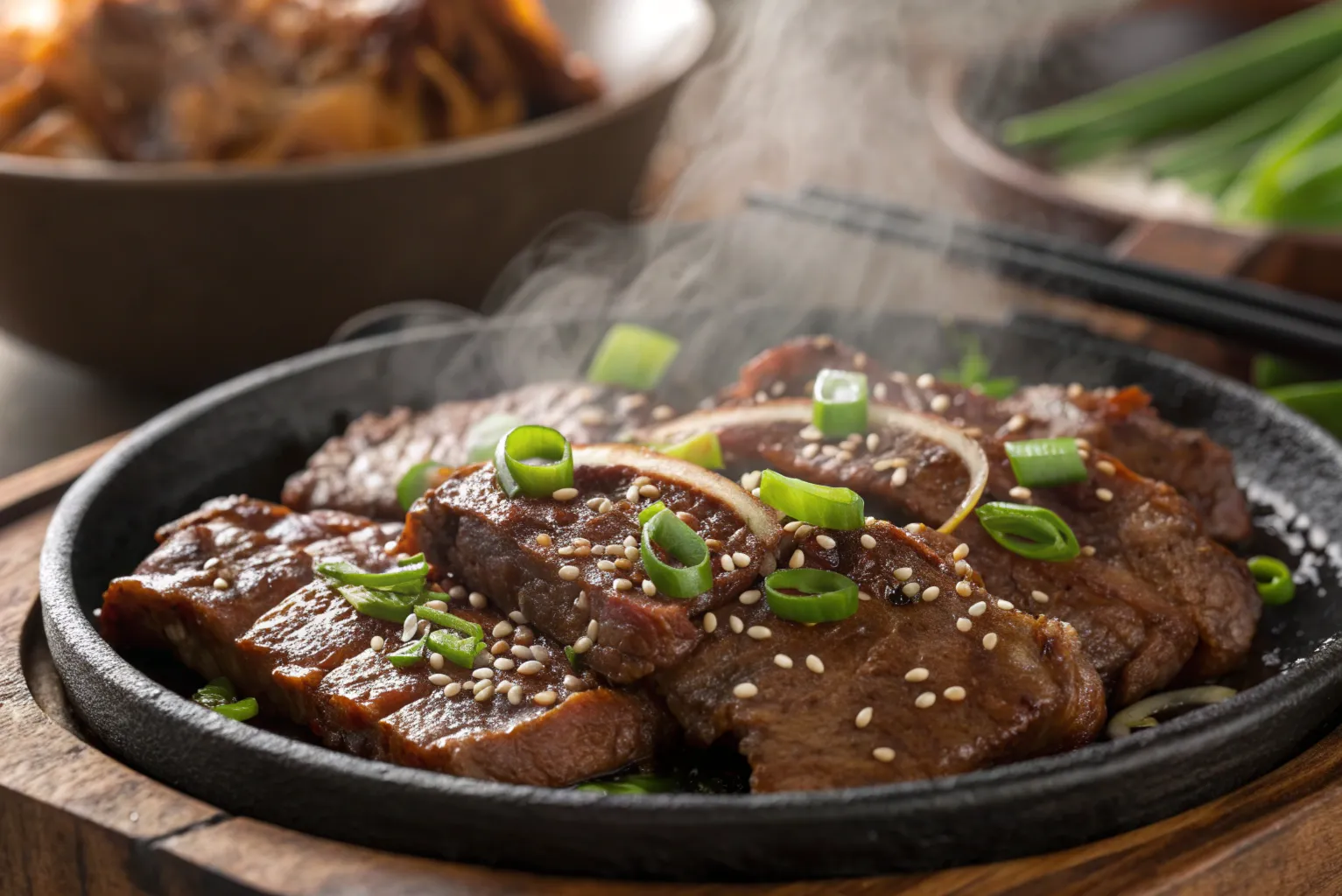Korean Beef – A Quick, Flavor-Packed Meal You’ll Crave

Korean beef dishes are loved worldwide for their rich, savory flavors balanced with a hint of sweetness and spice. This recipe captures the essence of classic Korean-style beef—tender, thinly sliced meat marinated in a delicious blend of soy sauce, garlic, ginger, and brown sugar. Whether served over steamed rice or tossed with fresh veggies, Korean beef is an easy, crowd-pleasing meal that comes together in under 30 minutes. Perfect for busy weeknights or casual gatherings, it delivers big flavor with minimal effort.
Why You’ll Love This Korean Beef Recipe
The beauty of Korean beef lies in its simplicity and depth of flavor. The marinade tenderizes the meat while infusing it with umami-rich soy, aromatic garlic, and a touch of sweetness. It cooks quickly, making it ideal for a fast dinner or meal prep. Plus, it pairs perfectly with rice, noodles, or even lettuce wraps for a low-carb option. This recipe is versatile, adaptable, and sure to become a favorite in your home cooking rotation.
Must-Try Korean Recipes
- Delicious Korean Fried Chicken – Soft, Easy & Juicy
- Korean BBQ Chicken – Flavorful, Tender, and Perfectly Glazed
- Vegan Jjajang Tteokbokki: Korean Black Bean Rice Cake Recipe
- Japchae Noodles at Home: Your Quick Ticket to Authentic Korean Flavor
Ingredients You’ll Need
To create the bold and savory flavors of Korean beef at home, you only need a handful of simple, accessible ingredients. This recipe combines tender, thinly sliced beef with a marinade rich in soy sauce, garlic, ginger, and a touch of sweetness from brown sugar. With a few pantry staples, you can recreate authentic Korean flavors that come together quickly and easily.
- 1 lb (450g) thinly sliced beef (ribeye, sirloin, or flank steak)
- ¼ cup soy sauce
- 2 tbsp brown sugar or honey
- 2 cloves garlic, minced
- 1 tsp freshly grated ginger
- 1 tbsp sesame oil
- 2 green onions, sliced
- 1 tsp red pepper flakes (optional, for heat)
- 1 tbsp vegetable oil (for cooking)
- Sesame seeds, for garnish
Nutritional Information
This Korean beef recipe is not only delicious but also provides a good balance of protein and essential nutrients. This makes for a satisfying, moderately low-carb meal packed with protein and flavor. Pair it with steamed vegetables or rice for a balanced plate. Here’s an approximate breakdown per serving (based on 4 servings):
- Calories: 320
- Protein: 28g
- Carbohydrates: 15g
- Sugars: 9g
- Fat: 14g
- Saturated Fat: 5g
- Fiber: 1g
- Sodium: 700mg
Time Breakdown
- Preparation Time: 10 minutes
- Marinating Time: 15-20 minutes (optional but recommended for best flavor)
- Cooking Time: 10 minutes
- Total Time: Approximately 30-40 minutes
How to Make Korean Beef – Step-by-Step

Making Korean beef is straightforward and perfect for busy cooks looking for a flavorful meal in under 30 minutes. From marinating the beef to quickly stir-frying it to perfection, this step-by-step guide ensures tender, juicy bites infused with rich, savory goodness. Follow along to learn how to get the perfect balance of sweet, salty, and spicy in every mouthful.
- Marinate the Beef: In a bowl, combine soy sauce, brown sugar, garlic, ginger, sesame oil, and red pepper flakes (if using). Add the thinly sliced beef and toss to coat. Let it marinate for at least 15 minutes, or up to an hour for deeper flavor.
- Cook the Beef: Heat vegetable oil in a large skillet over medium-high heat. Add the marinated beef in a single layer, cooking until browned and just cooked through, about 3-5 minutes. Avoid overcrowding the pan; cook in batches if needed.
- Finish and Garnish: Stir in sliced green onions during the last minute of cooking. Remove from heat and sprinkle with toasted sesame seeds.
- Serve: Enjoy the Korean beef over steamed white rice, alongside sautéed vegetables, or wrapped in fresh lettuce leaves for a delicious bite.
Ingredient Swaps and Custom Variations
One of the best things about this Korean beef recipe is its versatility. You can easily swap ingredients to suit your taste preferences or dietary needs. Whether you want to try a different protein, add extra veggies, or experiment with alternative sweeteners and spice levels, this recipe provides plenty of room for customization to keep things exciting.
- Substitute beef with thinly sliced chicken or pork.
- Add sliced mushrooms or bell peppers to the skillet for extra veggies.
- Use coconut sugar or maple syrup instead of brown sugar for a different sweetness.
- Make it spicier by increasing red pepper flakes or adding gochujang (Korean chili paste).
How to Store and Reheat Leftovers
Korean beef is not only delicious fresh off the stove but also makes a great leftover meal. Knowing how to store and reheat it properly ensures you can enjoy its flavors again without losing moisture or tenderness. This section covers simple tips for keeping your Korean beef fresh and tasty for days.
- Store leftovers in an airtight container in the fridge for up to 3 days.
- Reheat gently in a skillet or microwave until warmed through.
- Add a splash of water or soy sauce when reheating to keep the beef moist.
What to Serve with Korean Beef
The rich and flavorful Korean beef pairs beautifully with a variety of side dishes, from steamed rice to fresh greens. Whether you want a traditional Korean meal or a lighter, vegetable-forward plate, these serving suggestions will help you round out your meal for maximum satisfaction and balance.
- Steamed jasmine or short-grain rice
- Korean-style kimchi for a tangy crunch
- Stir-fried or steamed vegetables like bok choy, broccoli, or snap peas
- Fresh lettuce or perilla leaves for wrapping
Kid-Friendly Tips

Introducing kids to bold flavors can be fun and rewarding, and this Korean beef recipe is no exception. By tweaking the spice levels and pairing it with familiar sides, you can create a kid-friendly version that’s both nutritious and delicious. These tips will help you make the dish approachable for younger palates without sacrificing its authentic taste.
Final Thoughts – Quick, Flavorful, and Always Delicious
This Korean beef recipe is a perfect example of how simple ingredients and quick cooking can yield amazing results. It’s a go-to meal for busy weeknights or when you want a satisfying, restaurant-quality dish at home. Give it a try and bring the vibrant tastes of Korea to your table—your taste buds will thank you.

